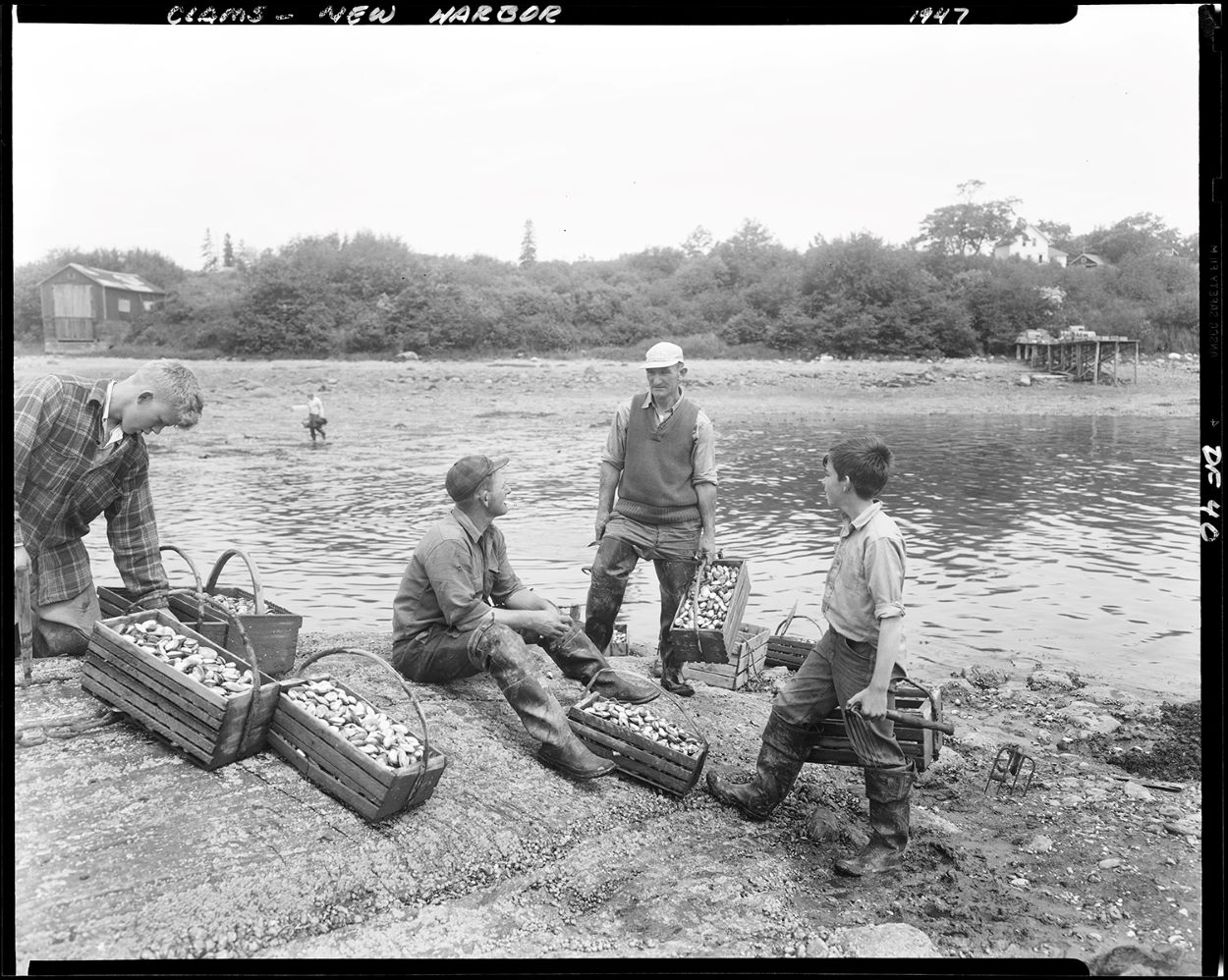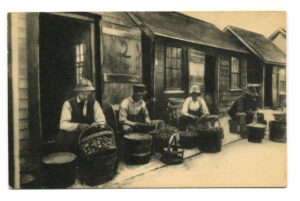
A brief history of soft-shell clam management in Maine
This text is excerpted from the recently published Maine Shellfish Handbook, which contains information on the history, management, and biology of the soft-shell clam, northern quahog, American and European oysters, and blue mussels.
For millennia, Wabanaki people have used soft-shell clams for food, trade, and cultural purposes, and continue to do so today. Historian George Neptune describes how the area around Mount Desert Island was an important gathering place for clamming and how soft-shell clams shaped human relationships with the place:
We came to Pesamkuk as a place in the summer to meet with other Wabanaki. People came from the south and down from Nova Scotia, all the way from Massachusetts, all the way to Newfoundland was our traditional territory. They would come from all over to meet and trade with each other, and hunt all over the island, and maybe get married in the summer because you were going to find somebody who wasn’t from your tribe or from your clan. And it was very much a thriving summertime metropolis almost in the way it is now, with smaller year-round communities, so the island has kept its history in that way. And the sand bar itself [from which Bar Harbor draws its name] we called Moneskatik, [which] means ‘the clam-digging place.’ So ‘ess’ is a clam and ‘moneskat’ means to gather clams, and then the ending ‘ik’ denotes a place, so Moneskatik. We would come here and gather clams off the sand bar. (Clark and Neptune 2014)
Large shell middens, or piles of leftover shells, provide evidence of how clams, mussels, and oysters have sustained coastal communities for thousands of years.
Over 2,000 shell middens occur along the Maine coast and provide evidence that between 2,200 and 1,000 years ago, Native Americans visiting the coast throughout the Gulf of Maine consumed oysters, clams, and other seafood as an important component in their seasonal diet (late winter and spring). Middens not only provide insight into past cultures and behaviors, but also can be used to learn about
climate change, sea-level rise, and other pre-historic abiotic and biotic conditions that regulated ancient shellfish populations (Sanger and Sanger 1997). Researchers are also studying these middens to learn more about the history of shellfishing and are trying to find ways to protect these historic artifacts from sea-level rise (Carpenter 2017).
Soft-shell clams also provided food for European colonists. Traditionally, harvesters worked the intertidal flats on a seasonal cycle, digging or hand-pulling soft-shell clams spring through fall and moving along the coast and digging wherever soft-shell clams were abundant and weather, tide, and local harvesting restrictions allowed. Family and friends worked together, often setting daily production goals. In the winter, some harvesters would move to areas that remained ice-free, while others would find alternative employment.

Before World War II, many people harvested soft-shell clams for personal consumption. During that period, fewer than 1,500 locally licensed harvesters worked professionally, and they sold mostly to canneries. Commercial harvesting took place mostly in fall and winter when other resources were scarce, and canneries needed to keep their production lines operating. Small volumes of fresh product were shipped out of Maine to other New England markets. The cold temperatures common to winter harvesting were thought to prevent pathogens and other health risks associated with pollution from untreated sewage, industrial waste, and household garbage. The first closure of flats due to pollution occurred in the 1930s in southern Maine.
Like today, harvesters typically measured their daily production in “barrels” (three bushels to a barrel, or about 150 pounds) and could land two or three barrels per tide. Harvesters often delivered their soft-shell clams directly and shucking houses flourished all along the coast. Before 1945, production for a typical harvester exceeded 1,000 bushels per year. Today, full-time harvesters land approximately 300 to 500 bushels of soft-shell clams annually.
In 1947, the state issued the first commercial shellfish licenses to 2,474 harvesters. State licensing was initiated to satisfy federal public health requirements for inter- state trade in shellfish and to allow the state to gather more reliable statistics on the soft-shell clam fishery.
In 1957, the Maine legislature restricted soft-shell clam harvesting to hand implements only, such as a steel-tined hoe (also called a “fork”) or picking by hand (sometimes called “pulling”), in softer mudflats.
Techniques to spawn adult soft-shell clams and culture larvae and juveniles in the laboratory were developed in 1977 at the University of Maine’s Ira C. Darling Marine Center in Walpole. This technology was adapted and improved in the mid-1980s at the Beals Island Regional Shellfish Hatchery (BIRSH), a project associated with the University of Maine at Machias. In 2001, BIRSH became the Downeast Institute (DEI), and today the organization continues to operate the state’s only public shellfish hatchery and production center that produces juvenile soft-shell clams and seed for other commercial shellfish.
After 1990, improvements in water quality, among other factors, allowed for harvesters to fish year-round. Now, many areas experience the heaviest fishing effort during late spring and summer when temperatures, demand, and price are highest.
Today, the Maine soft-shell clam fishery remains one with low costs to entry. Since 2010, soft-shell clams have been Maine’s second or third most valuable commercially harvested marine species. In 2019, 7.8 million pounds of soft-shell clams were landed with a dockside value of $18.2 million, making the fishery tied with elver as the second most valuable fishery in the state behind lobster. It was also second in fishery employment behind lobster. In 2018, the industry employed more than fifteen hundred harvesters along the coast. When including activities such as shucking, transporting, and wholesale, retail, and restaurant sales, the industry yields an estimated total economic benefit of $67.5 million. Maine is a major contributor to overall soft-shell clam landings nationwide, contributing 62.2% to the total U.S. soft-shell landings and 65% of the total value of the U.S. fishery (Evans et al. 2016).
Still, the fishery faces challenges. Dockside landings in 2017 were the lowest recorded since the 1920’s (John- son et al. 2014), and in the last forty years, state clam landings have decreased by nearly 75% (Beal et al. 2016, Figure 1). Current research conducted in Maine (Beal et al. 2018, 2020a, 2020b), as well as other intertidal locations in downeast and midcoast Maine suggest that warming seawater temperatures in the Gulf of Maine over the past decade (Pershing et al. 2015) have coincided with increases in predator populations, such as the invasive green crab (Carcinus maenas) and the native milky ribbon worm (Cerebratulus lacteus).
Posted 6 October 2021
